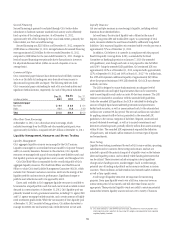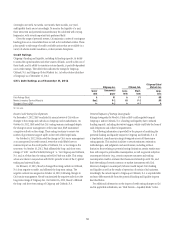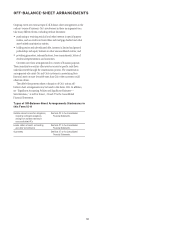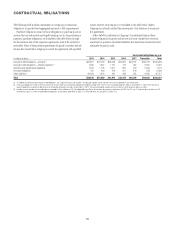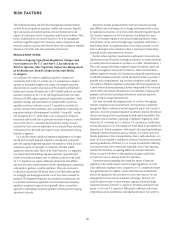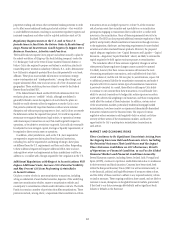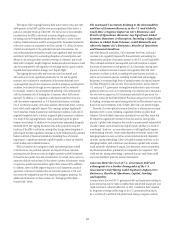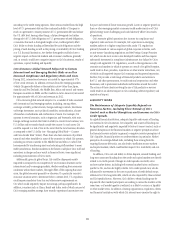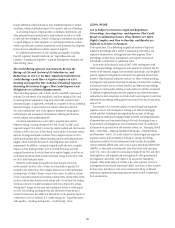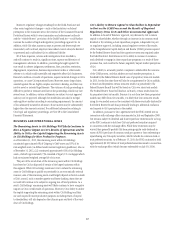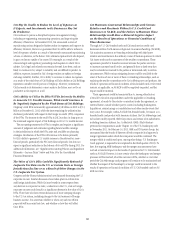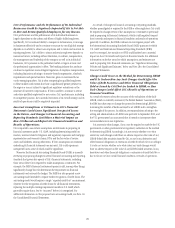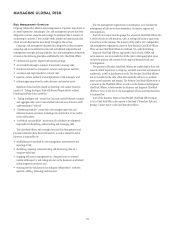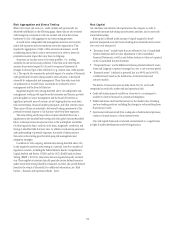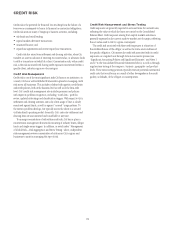Citibank 2012 Annual Report Download - page 87
Download and view the complete annual report
Please find page 87 of the 2012 Citibank annual report below. You can navigate through the pages in the report by either clicking on the pages listed below, or by using the keyword search tool below to find specific information within the annual report.65
According to the credit rating agencies, these actions resulted from the high
level of U.S. government debt and the continued inability of Congress to
reach an agreement to ensure payment of U.S. government debt and reduce
the U.S. debt level. Among other things, a future downgrade (or further
downgrade) of U.S. debt obligations or U.S. government-related obligations,
or concerns that such a downgrade might occur, could negatively affect
Citi’s ability to obtain funding collateralized by such obligations and the
pricing of such funding as well as the pricing or availability of Citi’s funding
as a U.S. financial institution. Any further downgrade could also have a
negative impact on financial markets and economic conditions generally
and, as a result, could have a negative impact on Citi’s businesses, results of
operations, capital, funding and liquidity.
Citi’s Extensive Global Network Subjects It to Various
International and Emerging Markets Risks as well as
Increased Compliance and Regulatory Risks and Costs.
During 2012, international revenues accounted for approximately 57%
of Citi’s total revenues. In addition, revenues from the emerging markets
(which Citi generally defines as the markets in Asia (other than Japan,
Australia and New Zealand), the Middle East, Africa and central and eastern
European countries in EMEA and the markets in Latin America) accounted
for approximately 44% of Citi’s total revenues in 2012.
Citi’s extensive global network subjects it to a number of risks associated
with international and emerging markets, including, among others,
sovereign volatility, political events, foreign exchange controls, limitations
on foreign investment, socio-political instability, nationalization, closure
of branches or subsidiaries and confiscation of assets. For example, Citi
operates in several countries, such as Argentina and Venezuela, with strict
foreign exchange controls that limit its ability to convert local currency into
U.S. dollars and/or transfer funds outside the country. In such cases, Citi
could be exposed to a risk of loss in the event that the local currency devalues
as compared to the U.S. dollar (see “Managing Global Risk— Country
and Cross-Border Risk” below). There have also been instances of political
turmoil and other instability in some of the countries in which Citi operates,
including in certain countries in the Middle East and Africa, to which Citi
has responded by transferring assets and relocating staff members to more
stable jurisdictions. Similar incidents in the future could place Citi’s staff and
operations in danger and may result in financial losses, some significant,
including nationalization of Citi’s assets.
Additionally, given its global focus, Citi could be disproportionately
impacted as compared to its competitors by an economic downturn in the
international and/or emerging markets, whether resulting from economic
conditions within these markets, the ripple effect of the ongoing Eurozone
crisis, the global economy generally or otherwise. If a particular country’s
economic situation were to deteriorate below a certain level, U.S. regulators
could impose mandatory loan loss and other reserve requirements on
Citi, which could negatively impact its earnings, perhaps significantly. In
addition, countries such as China, Brazil and India, each of which are part of
Citi’s emerging markets strategy, have recently experienced uncertainty over
the pace and extent of future economic growth. Lower or negative growth in
these or other emerging market economies could make execution of Citi’s
global strategy more challenging and could adversely affect Citi’s results
of operations.
Citi’s extensive global operations also increase its compliance and
regulatory risks and costs. For example, Citi’s operations in emerging
markets subject it to higher compliance risks under U.S. regulations
primarily focused on various aspects of global corporate activities, such
as anti-money-laundering regulations and the Foreign Corrupt Practices
Act, which can be more acute in less developed markets and thus require
substantial investment in compliance infrastructure. Any failure by Citi to
comply with applicable U.S. regulations, as well as the regulations in the
countries and markets in which it operates as a result of its global footprint,
could result in fines, penalties, injunctions or other similar restrictions, any
of which could negatively impact Citi’s earnings and its general reputation.
Further, Citi provides a wide range of financial products and services to
the U.S. and other governments, to multi-national corporations and other
businesses, and to prominent individuals and families around the world.
The actions of these clients involving the use of Citi products or services
could result in an adverse impact on Citi, including adverse regulatory and
reputational impact.
LIQUIDITY RISKS
The Maintenance of Adequate Liquidity Depends on
Numerous Factors, Including Those Outside of Citi’s
Control such as Market Disruptions and Increases in Citi’s
Credit Spreads.
As a global financial institution, adequate liquidity and sources of funding
are essential to Citi’s businesses. Citi’s liquidity and sources of funding can
be significantly and negatively impacted by factors it cannot control, such as
general disruptions in the financial markets or negative perceptions about
the financial services industry in general, or negative investor perceptions of
Citi’s liquidity, financial position or creditworthiness in particular. Market
perception of sovereign default risks, including those arising from the
ongoing Eurozone debt crisis, can also lead to inefficient money markets
and capital markets, which could further impact Citi’s availability and cost
of funding.
In addition, Citi’s cost and ability to obtain deposits, secured funding and
long-term unsecured funding from the credit and capital markets are directly
related to its credit spreads. Changes in credit spreads constantly occur
and are market-driven, including both external market factors and factors
specific to Citi, and can be highly volatile. Citi’s credit spreads may also be
influenced by movements in the costs to purchasers of credit default swaps
referenced to Citi’s long-term debt, which are also impacted by these external
and Citi-specific factors. Moreover, Citi’s ability to obtain funding may be
impaired if other market participants are seeking to access the markets at the
same time, or if market appetite is reduced, as is likely to occur in a liquidity
or other market crisis. In addition, clearing organizations, regulators, clients
and financial institutions with which Citi interacts may exercise the right to


